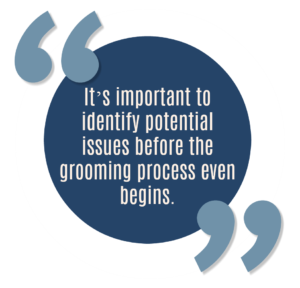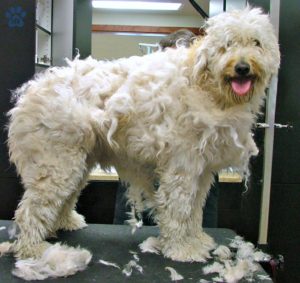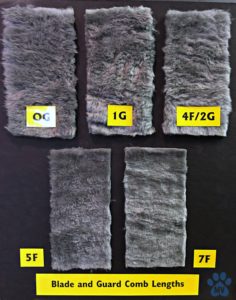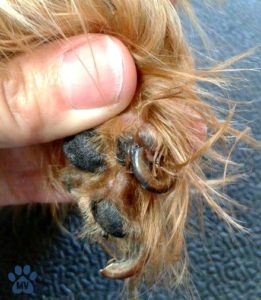- During bathing, a scab falls away from an older injury, making it look like a fresh wound.
- Removing tight mats from the leather results in an ear hematoma.
- A dog arrives for his appointment with fleas or ticks. However, the client refuses to believe their pet had them prior to stepping into your salon.
- After trimming a pet with super sensitive skin, an area becomes inflamed once it gets home.

How do you proactively handle these situations and prevent having upset customers?
Three ways.
- Communication
- Honesty
- Proof
Communication
The best start to effective communication is to get your hands on the pet before it goes into the grooming process – preferably with the owner standing right there. You’re going to be looking for anything unusual that could possibly pose a problem after the grooming is finished.
Let all your senses come into play.
- What does the skin and coat look like?
- What does the skin and coat feel like?
- What does the skin and coat smell like?

Give the dog a visual once over. Identify any potential problems. Confirm what you may see by sinking your hands into the coat all the way down to the skin. Is there anything unusual? Lumps? Bumps? Mats? Filthy coat? Grit next to the skin?
To be proactive, it’s important to identify potential issues before the grooming process even begins. With severely matted pets this is critical. Talk to the owner. Point out the issue and offer a solution if you can. Discuss the potential risks and the benefits you feel are in the best interest of the pet.
Identifying potential issues in the skin and coat prior to starting the grooming process is a great way to start educating customers. Many clients have no idea how to best deal with their pet’s coat, the health risks associated with the lack of regular grooming, temperament issues, or the aging process. Most want to do what is best for their pet if information is presented in a sincere and respectful manner.
 Owners rarely understand how we do our job or how our clippers work. Telling a client is one thing. Having a fake fur chart of how long each blade or guard comb leaves the pet can be extremely beneficial. It’s a physical tool to help educate pet parents. It clarifies blade lengths and defines the term “short” in a way clients can comprehend.
Owners rarely understand how we do our job or how our clippers work. Telling a client is one thing. Having a fake fur chart of how long each blade or guard comb leaves the pet can be extremely beneficial. It’s a physical tool to help educate pet parents. It clarifies blade lengths and defines the term “short” in a way clients can comprehend.
Some salons display solid pelts taken off severely matted pets. These matted chunks of coat – or pelts – serve as a great education tool. It’s not just for severely matted pets. They offer an excellent communication tool to talk about coat length, brushing techniques, and things hidden in the coat like bubblegum or fishhooks.
Unfortunately, we all have a few clients who are just impossible to educate. Careful, I can see your eyes rolling…
Let’s face it. During check-in we can’t always spot every potential problem in the dog’s skin or coat. If it is going to change the price or the look of the haircut, stop and call the owner to discuss it. If it’s extremely matted and is going to cost more to do the groom – you want to get verification to either proceed with the dematting process or opt for a much shorter haircut.
Personally, I prefer to emphasize the risks and slightly over estimate the cost when I’m first talking to the owner. Thus, whatever I might find – or charge – is a welcome relief to the pet parent upon pick-up. If you do accidentally injure the dog or must charge extra, it does not come as a shock to the owner. In most cases, injury can be avoided, and the groom is less expensive than anticipated.
Whatever the case, it’s better to have too much communication then not enough.
Honesty
Whatever you have found in the dog’s skin or coat, be truthful with the client.
If it’s something minor, take the time to point it out and clearly show it to the owner. Tell them what you have done to help minimize the issue. Make suggestions on what they should do at home. Maybe it’s just keeping an eye on the spot or using some pet soothing appointment. If the issue has the potential to be a long-term problem, tell them how you plan to deal with it in upcoming grooming appointments, so you don’t aggravate the problem in the future.
We literally go over pets from the tips of their noses to the tips of their tails. It’s amazing what we discover as professionals. We are not vets and should never diagnose our discoveries, but we are trained observers. Whenever you find something out of the ordinary, tell the owner.
If I were to find anything I would consider a medical issue, it would be best to tell the owner what I would do if it was MY dog. Sometimes it would just be keeping an eye on something until the next vet visit. On other occasions where I feel it is critical the pet receives medical attention, I would tell the owner (if it was my dog), I would go straight to the veterinarian. I’ve even had a few situations where I called the vet for the owner and they went directly from the grooming appointment to the veterinarian.
We are all working in the best interest of the pet. Honesty can go a long way, coupled with sincerity and compassion for both the pet and the owner.
 Proof
Proof
If you overlooked something at check-in, but discover it after the owner has left, document it. Having proof about the condition when the owner returns helps prove it was a pre-existing issue. It helps establish your case that you did not cause the problem prior to the grooming.
There are many ways to document or provide proof of the pre-existing problem.
Almost everyone has a cell phone with a digital camera. Use it! A photo or a quick video does wonders to prove a point. It’s important to get that initial shot when you first discover a problem. It might be a scab or flea dirt and fleas crawling through the coat. It might be a toenail that has curled into the foot pad.
Here are a few of the items I have collected over the years. Most of the smaller items have been put into plastic baggies.
- fleas (preferably dead)
- ticks (preferably dead)
- maggots
- hotspots
- scabs and pus
- bubblegum
- rubber bands
- fishhooks
- burrs
- matts
- pelts
- pine sap
- grossly overgrown toenails
- excessive blown or dead coat
I’m sure you have an extensive list, as well.
If you don’t want to get blamed for something, be proactive. Honestly discuss what you have found with the pet owner. You are the professional observer and trained professional. As a professional groomer, our job is not only to make the dogs look and feel better, it’s also to educate their caretakers.
Always remember, put humanity before vanity and do what is in the best interest of the pet.
Happy trimming!
Melissa

Have you ever been blamed for an injury you didn’t cause? How did you handle it? Let’s talk about it on our Facebook page with your Melissa Verplank family.


